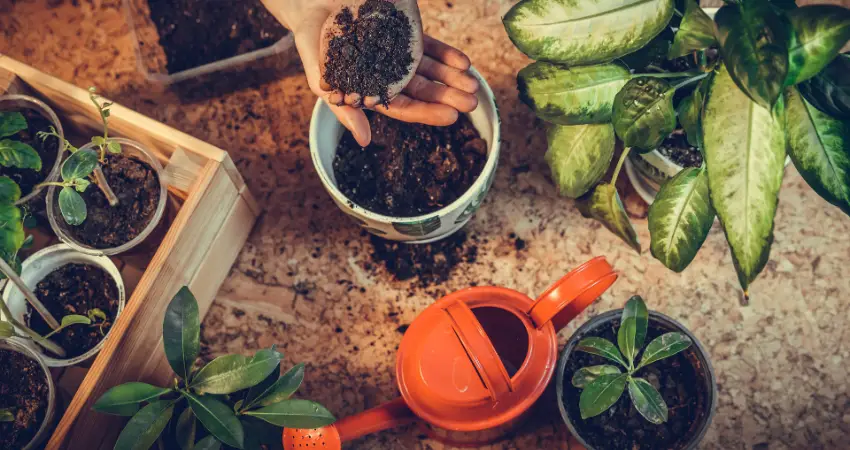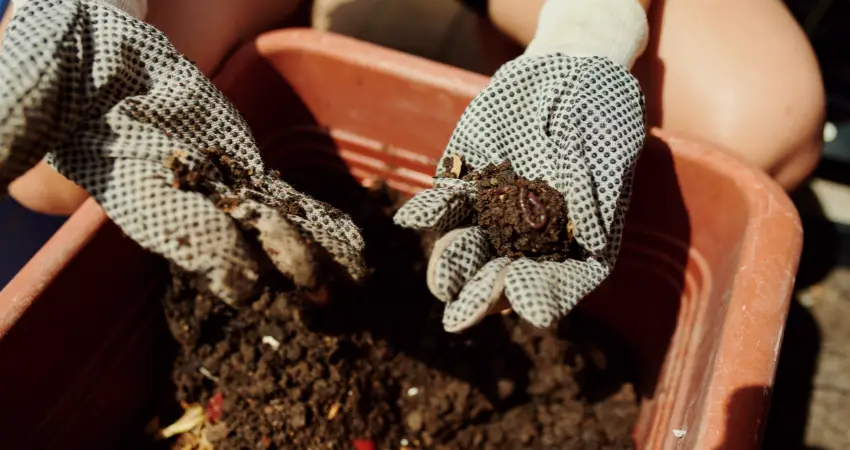In the world of houseplant care, proper fertilization is crucial for ensuring healthy growth and vibrant foliage or blooms. With a plethora of fertilizers available on the market, it can be challenging to determine which option is best for your beloved indoor plants.
This comprehensive guide aims to clarify the differences between organic and synthetic fertilizers, delving into their unique characteristics, advantages, and disadvantages. Additionally, we’ll provide valuable tips for using each type effectively and responsibly.
By understanding the intricacies of organic and synthetic fertilizers, you’ll be well-equipped to make an informed decision that caters to your plants’ specific needs and supports a thriving indoor garden.
Importance of Fertilizers for Houseplants

Fertilizers play a crucial role in the health and growth of houseplants. Although plants can obtain some nutrients from soil, sunlight, and water, additional supplementation is often required to ensure they receive the essential nutrients they need to thrive. Fertilizers can provide these vital nutrients in the correct proportions, leading to numerous benefits:
- Improved growth: Fertilizers can boost houseplant growth by providing essential nutrients, such as nitrogen, phosphorus, and potassium, which promote strong roots, lush foliage, and beautiful blooms.
- Enhanced health: A well-fertilized houseplant is better equipped to resist diseases and pests, as the nutrients help strengthen its immune system and overall vitality.
- Longer lifespan: By supplying the necessary nutrients, fertilizers can extend the lifespan of houseplants, allowing them to reach their full potential and maintain their beauty for a longer period.
- Increased aesthetic appeal: Houseplants with the proper nutrient balance are more vibrant, boasting lusher foliage and more vibrant blooms, which can enhance the overall aesthetic of your living space.
Organic vs. Synthetic Fertilizers
Fertilizers can generally be classified into two main categories – Organic and Inorganic (or Synthetic). Organic and synthetic fertilizers differ in their composition, nutrient release rate, and impact on soil health and the environment.
Understanding these differences is vital for selecting the right fertilizer for your houseplants.
- Composition: Organic fertilizers are derived from natural sources such as plant, animal, or mineral matter, while synthetic fertilizers are manufactured using chemical processes. Organic fertilizers often contain a broader range of nutrients, while synthetic fertilizers typically consist of specific nutrient ratios (NPK).
- Nutrient release rate: Organic fertilizers release nutrients more slowly, as they must be broken down by soil microbes before plants can use them. This slow-release process provides a steady supply of nutrients over time. Synthetic fertilizers, on the other hand, are more readily available to plants, resulting in a faster nutrient release rate and more immediate effects.
- Soil health: Organic fertilizers can improve soil structure, increase microbial activity, and enhance the soil’s ability to retain water and nutrients. Synthetic fertilizers, in contrast, may contribute to soil compaction, decreased microbial activity, and salt buildup over time.
- Environmental impact: Organic fertilizers are generally considered more environmentally friendly because they come from renewable resources and promote healthy soil ecosystems. Synthetic fertilizers can contribute to environmental issues such as nutrient runoff, pollution, and eutrophication in water bodies.
Let’s explore this two categories more in details.

Organic Fertilizers
Organic fertilizers are derived from natural sources, such as plant or animal byproducts. They offer numerous benefits, including:
- Slow-release of nutrients
- Improved soil health
- Reduced environmental impact
Types of Organic Fertilizers
Organic fertilizers come in various forms, including:
- Compost
- Manure
- Worm castings
- Seaweed
- Fish emulsion
- Bone meal
- Blood meal
- Bat guano
- Alfalfa meal
Each type of organic fertilizer offers a unique blend of nutrients, making it essential to select the appropriate option for your houseplants’ specific needs.
Application Methods
Organic fertilizers can be applied using several methods, such as:
- Topdressing – adding a layer of fertilizer to the soil surface
- Liquid fertilization – mixing fertilizer with water and applying to the soil
- Compost tea – a liquid solution made from steeping compost in water
Advantages of Organic Fertilizers
Organic fertilizers offer several benefits that contribute to both plant health and environmental sustainability:
- Slow-release nutrients – Organic fertilizers break down slowly, providing a steady supply of nutrients over an extended period. This gradual release helps prevent nutrient leaching and promotes consistent growth.
- Soil health improvement – Organic fertilizers improve soil structure, increase water retention, and support beneficial microorganisms, all of which contribute to a healthier root system and more robust plants.
- Environmentally friendly – Organic fertilizers are derived from natural sources and typically have a lower environmental impact compared to synthetic fertilizers. They reduce the risk of nutrient runoff and groundwater contamination.
Disadvantages of Organic Fertilizers
Despite their numerous advantages, organic fertilizers also have some drawbacks:
- Lower nutrient concentrations – Organic fertilizers generally have lower nutrient concentrations than synthetic alternatives. As a result, you may need to apply larger quantities to achieve the desired results.
- Variable nutrient composition – The nutrient composition of organic fertilizers can be less consistent than synthetic options due to variations in raw materials and production processes.
- Cost and availability – Organic fertilizers can be more expensive and harder to find than synthetic options, particularly in specialized formulations or large quantities.
Tips for Using Organic Fertilizers
To maximize the benefits of organic fertilizers for your houseplants, consider these tips:
- Choose the right type – Select the most suitable organic fertilizer based on your plants’ needs and preferences. For instance, bone meal is an excellent source of phosphorus, while seaweed provides a wealth of micronutrients.
- Combine different organic fertilizers – Mixing different organic fertilizers can help create a more balanced nutrient profile tailored to your plants’ requirements.
- Rotate fertilizer types – Regularly switch between different organic fertilizers to provide a diverse array of nutrients and prevent nutrient imbalances.
Synthetic Fertilizers

Synthetic fertilizers are chemically-produced and offer a fast-acting source of nutrients for houseplants. Benefits include:
- Quick nutrient availability
- Customizable formulations
- Ease of use
Types of Synthetic Fertilizers
Synthetic fertilizers are available in various forms, such as:
- Granular fertilizers
- Liquid fertilizers
- Slow-release fertilizers
- Water-soluble fertilizers
Nutrient Ratios
Synthetic fertilizers often display an N-P-K ratio, representing the percentage of nitrogen (N), phosphorus (P), and potassium (K) in the product. Additionally, they may contain essential micronutrients.
Application Methods
Application methods for synthetic fertilizers include:
- Soil application
- Foliar feeding
- Fertigation (fertilizer + irrigation)
Advantages of Synthetic Fertilizers
Synthetic fertilizers offer several benefits that make them a popular choice for many houseplant enthusiasts:
- Fast-acting nutrients – Synthetic fertilizers are readily available to plants, providing an immediate nutrient boost. This can be especially helpful for plants exhibiting signs of nutrient deficiencies or those in need of rapid growth.
- Customizable formulations – With synthetic fertilizers, you can create a custom nutrient blend tailored to your plants’ specific needs. This flexibility allows for precise control over the nutrient delivery.
- Ease of use and measurement – Synthetic fertilizers are generally easy to measure and apply, ensuring consistent nutrient delivery.
Disadvantages of Synthetic Fertilizers
Synthetic fertilizers also have some drawbacks that warrant consideration:
- Potential environmental impact – The production and use of synthetic fertilizers can contribute to environmental issues such as nutrient runoff, groundwater contamination, and greenhouse gas emissions.
- Over-fertilization risk – Synthetic fertilizers can quickly lead to over-fertilization if not applied correctly, causing damage to plants and potentially harming beneficial soil organisms.
- Limited impact on soil health – Synthetic fertilizers focus on providing nutrients, but they do not improve soil structure or support beneficial microorganisms in the same way organic fertilizers do.
Tips for Using Synthetic Fertilizers
To optimize the use of synthetic fertilizers for your houseplants, consider these tips:
- Follow manufacturer’s instructions – Adhere to the recommended application rates and dilution guidelines to avoid over-fertilization and potential plant damage.
- Monitor plant health – Regularly observe your plants for any signs of nutrient deficiencies or over-fertilization, and adjust your fertilization practices accordingly.
- Choose the right formulation – Select a synthetic fertilizer with an appropriate N-P-K ratio and micronutrient composition to meet your plants’ specific needs. For example, flowering plants often require higher phosphorus levels, while foliage plants may benefit from increased nitrogen.
- Combine synthetic and organic methods – Consider using a combination of synthetic and organic fertilizers to enjoy the advantages of both. For instance, you could apply a synthetic fertilizer for an immediate nutrient boost, followed by organic amendments to improve soil health and provide a slow-release nutrient source.
- Store synthetic fertilizers properly – Keep synthetic fertilizers in a cool, dry place, away from direct sunlight and moisture, to maintain their effectiveness and prevent degradation.
Factors to Consider When Choosing a Fertilizer

When selecting a fertilizer for your houseplants, consider the following factors:
- Plant species and specific needs: Different plants have unique nutrient requirements. Some may need more nitrogen for foliage growth, while others might require more phosphorus for blooming. Consider your plant’s specific needs when selecting a fertilizer, and choose between organic or synthetic options accordingly.
- Soil type and pH: The soil’s texture and pH can impact nutrient availability. Organic fertilizers can help improve soil structure and gradually adjust pH levels, while synthetic fertilizers may cause salt buildup or alter pH more quickly. Evaluate your indoor plant’s soil to decide which fertilizer is best suited to your situation.
- Nutrient availability: Organic fertilizers typically release nutrients slowly, providing a steady supply over time. Synthetic fertilizers, on the other hand, are fast-acting, with nutrients readily available for plant uptake. Depending on your plants’ needs and your desired results, you can select a fertilizer that best matches the desired nutrient release rate.
- Application frequency and methods: Organic fertilizers may require more frequent applications, while synthetic fertilizers usually require fewer applications but in precise amounts. Consider your schedule and preferred method of application (e.g., granular, liquid, or slow-release) when choosing a fertilizer for your indoor plants.
- Personal preferences and gardening style: Some gardeners prefer organic fertilizers because they align with their gardening philosophy or are derived from natural sources. Others might prioritize convenience and quick results, opting for synthetic fertilizers. Reflect on your preferences and gardening style to help guide your decision.
- Environmental impact: Organic fertilizers are generally considered more eco-friendly as they derive from renewable resources and promote healthy soil. Synthetic fertilizers can contribute to environmental issues such as nutrient runoff and pollution. Consider the environmental impact when selecting a fertilizer for your indoor plants, especially if sustainability is a priority for you.
By taking these factors into account, you can make an informed decision about which type of fertilizer best suits your houseplants’ needs.
Tips for Fertilizing Houseplants
To ensure optimal plant health, follow these tips for fertilizing houseplants:
- Timing and frequency – Fertilize houseplants during their active growth periods, typically spring and summer, and follow the recommended application frequency for your chosen fertilizer.
- Proper dilution and application – Dilute fertilizers according to the manufacturer’s instructions and apply them evenly to the soil or foliage, as directed.
- Signs of nutrient deficiencies – Watch for symptoms such as yellowing leaves, slow growth, and weak stems, which may indicate a nutrient deficiency.
- Signs of over-fertilization – Be on the lookout for symptoms of over-fertilization, such as burned leaf tips, wilting, and excessive growth.
- Monitoring and adjusting – Regularly monitor your houseplants and adjust your fertilization practices as needed to maintain plant health.
Conclusion
Proper fertilization is essential for healthy, thriving houseplants. Both organic and synthetic fertilizers have their advantages and drawbacks, so it’s important to weigh these factors when choosing the best option for your plants. Ultimately, the right fertilizer choice will depend on your specific plants, their needs, and your personal preferences. By understanding the differences between organic and synthetic fertilizers and following proper fertilization techniques, you can help your houseplants flourish.
